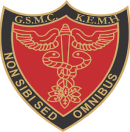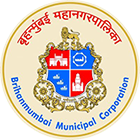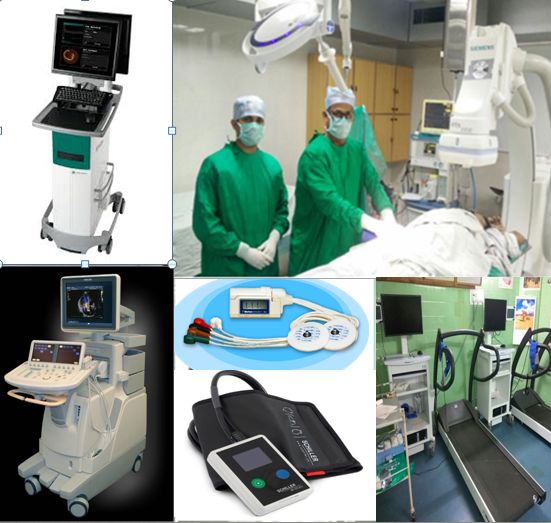
KING EDWARD MEMORIAL HOSPITAL
SETH GORDHANDAS SUNDERDAS MEDICAL COLLEGE
बृहन्मुंबई महानगरपालिका रुग्णालय


KING EDWARD MEMORIAL HOSPITAL
SETH GORDHANDAS SUNDERDAS MEDICAL COLLEGE
बृहन्मुंबई महानगरपालिका रुग्णालय


The Dr K.K.Datey Department of Cardiology is located on the 4th Floor of the Cardiovascular and Thoracic Centre (CVTC). The CVTC building is located in a separate small campus opposite to that of the Main building of the KEM Hospital. This centre caters to all aspects of cardiology and has a separate department of Cardiovascular and Thoracic Surgery, Pulmonary Medicine and Cardiac Pathology in the same wing.
The Cardiology department has a 22 bed ICCU for adult patients & 4 paediatric beds along with a 50-bed ward. The non-invasive laboratory has facilities for exercise stress electrocardiography, color Doppler echocardiography, Transesophageal echocardiography , stress echocardiography, strain imaging, ambulatory Holter monitor and ambulatory blood pressure monitor. The cardiac catheterization laboratory performs adult as well as pediatric, structural and electrophysiological diagnostic as well as therapeutic procedures such as coronary angiography, PCI, balloon valvotomies, transcatheter device closure of ASD, VSD, PDA, RSOV, CC Fistula, septal ablation for HOCM, single and dual chamber pacemaker implantations, ICDs, CRT-P/D, Radiofrequency catheter ablation of arrhythmias. Recently, Activated Clotting Time (ACT) machine & Optical Coherence Tomography (OCT) machines have also became reality, opening new horizons for complex interventions.
We run general cardiology OPDs on Mondays, Tuesdays and Fridays from 8.30 am to 1.00 pm. There is a special pediatric cardiology OPDs on Thursdays from 1.30 pm to 3.00 pm and an Arrhythmia clinic on Monday mornings.

Department of Cardiology
The annual admissions to the ICCU of 2500 consists of patients with acute myocardial infarction, unstable angina, congestive heart failure, end stage heart failure, complex life threatening arrhythmias, which consists of tachyarrhythmias and various degrees of symptomatic heart blocks, hypertensive emergency, pericardial tamponade, Infective endocarditis causing hemodynamic compromise and valvular heart disease associated with low output state and pulmonary edema. This ICCU also caters to the patients with post catheterization complications.
The ICCU is well equipped with one Senior Registrar and two Junior Doctors catering the patients 24 hours a day. All the beds have a cardiac monitoring system which caters to electrocardiographic monitoring .There is a central monitor which has the facility for recording and storing on-line ECG tracings of the ICCU admitted patients . There are facilities for temporary pacing, Defibrillation, Oxygenation, Invasive hemodynamic monitoring which include monitoring of CVP, Pulmonary capillary wedge pressure, and intra-arterial blood pressure. The ICCU has 6 volume- cycled ventilators, which are used for ventilation when indicated. The ICCU also has its own portable 2D Echo machine, which is used for cardiac screening of the admitted patients. The average stay of an uncomplicated infarct here is 2 days. The stay of the other patients varies as per their general condition and the indication for their admission. After the emergency treatment in the ICCU the patients are then shifted to the intermediate unit. The various procedures performed in the ICCU consists of Temporary pacing, defibrillation, invasive hemodynamic monitoring as discussed, pericardiocentesis, Permanent Pacemaker checkups and Evaluation of ICD’s .
The intermediate care consists of 10 beds and mainly has patients who have been stablised in the ICCU. This also has facilities for acute care, as that in the ICCU when needed. The patients are transferred from the Intermediate to the ward when they are stable.
The Cardiology ward has 32 beds with separate wings for female and male patients.
It caters to the admissions from the OPD, the patients admitted for cardiac catheterizations , and those transferred from the ICCU and the intermediate. The ward is catered by one resident doctor and a junior doctor. There is one sister in charge for the ward and 2 junior staff Nurses at a time who look after the patients in the ward.
The patient management in the ward is supervised by a senior doctor everyday. The ward also has all the facilities for emergency treatment when required.
The department has two Cardiac Catheterization laboratory to provide the state of art medical treatment to the patients. At present one is under renovation and other one is a state-of-the-art Siemens Artis-Zee laboratory located close to the ICCU over an area of 800 square feet. It is well equipped with all the essential pre-requisites needed for cardiac catheterization and emergency medical care. There is also a separate Electrophysiology Unit within the Cath. lab where there is the latest equipment for carrying out diagnostic and therapeutic electrophysiology studies.
The number of catheterizations performed per year is around 2600, with all types of diagnostic and therapeutic catheterizations. The procedures performed are coronary angiography 1400/yr, Balloon Mitral Valvotomy 150/yr, Coronary angioplasty 500/yr, pediatric catheterizatons 200/yr, and others 200/yr. We have started primary PCI (PPCI or PAMI) of patients presenting with acute coronary syndrome to the EMS. The cardiology registrar who is posted in the EMS, immediately transfers patient to cath lab for PAMI. Also, there is facility for wi-fi enabled ECG transmission. We have performed over 50 PAMIs till date. KEM is the major public hospital in the city of Mumbai which caters to neonatal and pediatric cardiology and various types of diagnostic and Interventional catheterizations are performed here. The pediatric interventions performed are transcatheter Device closure of the ASD, VSD, PDA, RSOV, CC fistula, aorto pulmonary window closure, Balloon atrial septostomy, Balloon pulmonary valvotomy, Balloon aortic valvotomy, PDA coil closure, pulmonary artery stenting, aorto pulmonary collaterals closure (MAPCA), Also KEM, has the largest series of the PDA coil closures, Inoue balloon BPV, TCC of RSOV in the Western and Southern India.
Among coronary interventions we do ultrasonograhy (IVUS) guided angioplasty of left main and proximal LAD artery on regular basis. We also perform rotational atherectomy for highly calcified lesions. We have successfully performed device closure of four patients presenting with post ischemic ventricular septal rupture (PIVSR) in 2016. We have recently started optical coherence tomography guided angioplasty, which has added new dimension to patient care.
The Catheterization lab is well equipped with doctors and paramedical personnel. There are always four technicians, four servants, one Chief Sister in-charge and two Staff-nurses in the Lab all the time. There is always one senior consultant, one junior consultant and three resident doctors working in the lab. The lab is functional from7 AM to 8 PM with 24/7 emergency facilities. All the interventions are done with a CVTS back up in case of a complication with a very low morbidity and mortality.
Price list of drug eluting Coronary stents used in Department of Cardiology (w.e.f. 1/7/2017)
| Sr.No. | Company’s Name | Stent’s Name | Base Price | CGST & SGST | Final Price |
| 1 | Medtronic | Endeavour Resolute | 22,500.00 | 1125.00 | 23,625/- |
| 2 | Medtronic | Endeavour Sprint | 13,000.00 | 650.00 | 13,650/- |
| 3 | Abbott | Xience Prime | 22,500.00 | 1125.00 | 23,625/- |
| 4 | Abbott | Xience V | 23,809.00 | 1190.00 | 24,999/- |
| 5 | Boston | Promus Element | 22,500.00 | 1125.00 | 23,625/- |
| 6 | Meril | Biomime | 22,714.28 | 1135.72 | 23,850/- |
Above list is compliant with NPPA guidelines issued on 14/2/2017.
The department of Cardiology of KEM has one of the best Electrophysiology (EP) set- ups in India. Both diagnostic and therapeutic studies are performed here.
The procedures consist of Radiofrequency ablation of various arrhythmias which include atrio-ventricular nodal reentrant tachycardia, WPW with overt and concealed preexcitation, Atrial tachycardia, Atrial Flutter, Idiopathic Ventricular tachycardia, Ischaemic Ventricular tachycardia , Bundle branch re-entrant tachycardia, AV nodal modualtion for atrial fibrillation and other diagnostic studies.
The work is carried out principally by faculty who have received EP training abroad & assisted by Assistant Professor & superspeciality Medical Officer resident doctors of the department. The success rate for the RF ablations here is more that 90 percent with a very low morbidity and negligible mortality.
In addition to the Electrophysiology studies there are a number of pacemaker and Intracardiac defibrillators implanted here. On an average around 100 dual chamber pacemakers and 70 single chamber pacemakers are implanted .on an average 25 intracardiac defibrillator implantation is also done per year. We also do 5-6 per year Cardiac resynchronization therapy (CRTP & CRTD) .
| Sr.No. | Name of the staff | Designation |
| 1. | Dr.Prafulla G. Kerkar | Professor & Head |
| 2. | Dr.Charan P. Lanjewar | Associate Professor & HOU |
| 3. | Dr.Hetan C. Shah | Associate Professor |
| 4. | Dr.Girish Sabnis | Assistant Professor |
| 6. | Dr.Dheeraj More | Assistant Professor |
| 7 | Mrs. Pratibha J.Sawant | Clerk cum Typist |
The department is well equipped with doctors and other paramedical personnel.
There is one Professor and Chief, two Associate Professors, three Assistant Professor in the faculty and two superspeciality medical officer. In addition, there are eighteen resident doctors working as a part of their Post Doctoral degree course in Cardiology, and two-three junior doctors from the department of Medicine who are posted here as part of their training in Cardiology.
The paramedical personnel include four Chief Staff Nurses, ten Junior Staff Nurses, two ECG technicians, two stress test Technicians, four cath lab technicians, two Echo technicians, ten servants and three Research technician. All the clerical work is done by one dedicated Clerk. With the addition of a second cath lab, more paramedical and support staff are expected.
The Department of Cardiology has set-up an electrophysiology program since 1995. The electrophysiology program primarily deals with abnormal cardiac rhythm & rate.
ELECTROPHYSIOLOGY PROGRAM :
Procedure

Placement of catheters in cardiac chambers
Electorphysiological studies (EPS) are performed in the cardiac catheterization laboratory that has special equipment to record electrograms from within the heart. In the study three or more catheters (long, flexible wires 1.5 to 2.0 mm diameter) are inserted into the heart (figure 1). The X-ray equipment is used to position the catheters in the chambers of the heart. The heart rhythm is monitored on a special screen to show the electrical pathway of each beat. The patient needs to be admitted to the hospital the day before, or the morning of the EPS. Blood tests, X-rays, ECGs and echocardiogram may be required when the patient is admitted. Fasting for 6 hours is required before the EPS. All anti-arrhythmic medications may be stopped for 48 to 72 hours before the procedure. An informed consent would be taken. Pregnant patient are deferred from EPS. The procedure is performed under local anesthesia and mild sedation would generally be used. For young children, general anesthesia would be used. Through the femoral route cahteters are introduced into the cardiac chambers. Tachycardia can be started with the help of these catheters and during tachycardia electrograms recorded through these catheters are used to study the presence of accessory pathway or abnormal foci. Once the abnormal circuit is determined, a special catheter is used to deliver radiofrequency current at that spot which would eliminate the accessory pathway or extra connection and prevent tachycardia. The procedure takes anywhere from 90 minutes to 3 hours. When the procedure is finished, the catheters are removed and hemostasis achieved. The patient is advised rest for 4 to 6 hours and the next day the dressing is removed and patient discharged. Strenous physical exercise and lifting heavy weights is to be avoided for 15
Appointment & waiting list :
The appointment for EPS & radiofrequency ablation is given in the arrhythmia clinic after the patient is seen in detail with all the ECGs & other reports. There is a waiting period of 15 days to 1 month for this procedure. Telephonic appointments are given to out of station patients who have already sent referring physicians notes and all ECGs and reports in advance.